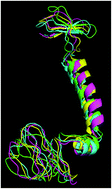A study on the structural features of SELK, an over-expressed protein in hepatocellular carcinoma, by molecular dynamics simulations in a lipid–water system†
Abstract
Human SELK is a small trans-membrane selenoprotein characterized by a single trans-membrane helix, while the N-terminal region protrudes into the lumen and the long C-terminal domain into the cytoplasm. SELK is over-expressed in some cancers, like hepatocellular carcinoma; however its precise role in cancer development is presently unknown. SELK is involved in promoting the calcium flux, catalyzing palmitoylation reactions and protein degradation in the endoplasmic reticulum (ER). Therefore, this protein should bind many different proteins like p97/VCP in the supramolecular complex involved in the ER degradation pathway. To study the structural features of SELK in the membrane, we have modeled the protein and then subjected it to molecular dynamics simulations in a lipid–water system. The model shows a N-terminal domain with three β-strands and a short helix, a well-defined trans-membrane helix and a C-terminal domain that lacks a persistent secondary structure and contains long disordered regions. The trajectory analysis during the simulation evidences that: (i) the N-terminal region explores a limited conformational space and is stabilized by intra-peptide H-bonds as well with membrane lipids and water, (ii) the trans-membrane helix was found to be quite stable and (iii) the disordered C-terminal region is stabilized by H-bonds with clustered water molecules as well as by rapidly interchanging intra-peptidic H-bonds, with a structural tendency to compact around the four HUB residues found for this domain. Moreover, N-terminal and C-terminal clusters are distributed differently in the conformational space suggesting that their dynamics are coupled complicatedly through the membrane. Further analyses have shown that the N-terminal has a tendency to pivot around the insertion with the TM-helix through the fluctuations of the three β-strands, which, in turn, show features similar to WW-domains. These results will be useful to study the SELK, SELS and VCP complex representing an interesting druggable target for cancer.


 Please wait while we load your content...
Please wait while we load your content...